- 您現(xiàn)在的位置:買賣IC網(wǎng) > PDF目錄368356 > PTM1300AEBEA (NXP SEMICONDUCTORS) Programmable Media Processor PDF資料下載
參數(shù)資料
| 型號: | PTM1300AEBEA |
| 廠商: | NXP SEMICONDUCTORS |
| 元件分類: | 消費(fèi)家電 |
| 英文描述: | Programmable Media Processor |
| 中文描述: | SPECIALTY CONSUMER CIRCUIT, PBGA292 |
| 封裝: | PLASTIC, SOT-553-1, BGA-292 |
| 文件頁數(shù): | 96/533頁 |
| 文件大小: | 6857K |
| 代理商: | PTM1300AEBEA |
第1頁第2頁第3頁第4頁第5頁第6頁第7頁第8頁第9頁第10頁第11頁第12頁第13頁第14頁第15頁第16頁第17頁第18頁第19頁第20頁第21頁第22頁第23頁第24頁第25頁第26頁第27頁第28頁第29頁第30頁第31頁第32頁第33頁第34頁第35頁第36頁第37頁第38頁第39頁第40頁第41頁第42頁第43頁第44頁第45頁第46頁第47頁第48頁第49頁第50頁第51頁第52頁第53頁第54頁第55頁第56頁第57頁第58頁第59頁第60頁第61頁第62頁第63頁第64頁第65頁第66頁第67頁第68頁第69頁第70頁第71頁第72頁第73頁第74頁第75頁第76頁第77頁第78頁第79頁第80頁第81頁第82頁第83頁第84頁第85頁第86頁第87頁第88頁第89頁第90頁第91頁第92頁第93頁第94頁第95頁當(dāng)前第96頁第97頁第98頁第99頁第100頁第101頁第102頁第103頁第104頁第105頁第106頁第107頁第108頁第109頁第110頁第111頁第112頁第113頁第114頁第115頁第116頁第117頁第118頁第119頁第120頁第121頁第122頁第123頁第124頁第125頁第126頁第127頁第128頁第129頁第130頁第131頁第132頁第133頁第134頁第135頁第136頁第137頁第138頁第139頁第140頁第141頁第142頁第143頁第144頁第145頁第146頁第147頁第148頁第149頁第150頁第151頁第152頁第153頁第154頁第155頁第156頁第157頁第158頁第159頁第160頁第161頁第162頁第163頁第164頁第165頁第166頁第167頁第168頁第169頁第170頁第171頁第172頁第173頁第174頁第175頁第176頁第177頁第178頁第179頁第180頁第181頁第182頁第183頁第184頁第185頁第186頁第187頁第188頁第189頁第190頁第191頁第192頁第193頁第194頁第195頁第196頁第197頁第198頁第199頁第200頁第201頁第202頁第203頁第204頁第205頁第206頁第207頁第208頁第209頁第210頁第211頁第212頁第213頁第214頁第215頁第216頁第217頁第218頁第219頁第220頁第221頁第222頁第223頁第224頁第225頁第226頁第227頁第228頁第229頁第230頁第231頁第232頁第233頁第234頁第235頁第236頁第237頁第238頁第239頁第240頁第241頁第242頁第243頁第244頁第245頁第246頁第247頁第248頁第249頁第250頁第251頁第252頁第253頁第254頁第255頁第256頁第257頁第258頁第259頁第260頁第261頁第262頁第263頁第264頁第265頁第266頁第267頁第268頁第269頁第270頁第271頁第272頁第273頁第274頁第275頁第276頁第277頁第278頁第279頁第280頁第281頁第282頁第283頁第284頁第285頁第286頁第287頁第288頁第289頁第290頁第291頁第292頁第293頁第294頁第295頁第296頁第297頁第298頁第299頁第300頁第301頁第302頁第303頁第304頁第305頁第306頁第307頁第308頁第309頁第310頁第311頁第312頁第313頁第314頁第315頁第316頁第317頁第318頁第319頁第320頁第321頁第322頁第323頁第324頁第325頁第326頁第327頁第328頁第329頁第330頁第331頁第332頁第333頁第334頁第335頁第336頁第337頁第338頁第339頁第340頁第341頁第342頁第343頁第344頁第345頁第346頁第347頁第348頁第349頁第350頁第351頁第352頁第353頁第354頁第355頁第356頁第357頁第358頁第359頁第360頁第361頁第362頁第363頁第364頁第365頁第366頁第367頁第368頁第369頁第370頁第371頁第372頁第373頁第374頁第375頁第376頁第377頁第378頁第379頁第380頁第381頁第382頁第383頁第384頁第385頁第386頁第387頁第388頁第389頁第390頁第391頁第392頁第393頁第394頁第395頁第396頁第397頁第398頁第399頁第400頁第401頁第402頁第403頁第404頁第405頁第406頁第407頁第408頁第409頁第410頁第411頁第412頁第413頁第414頁第415頁第416頁第417頁第418頁第419頁第420頁第421頁第422頁第423頁第424頁第425頁第426頁第427頁第428頁第429頁第430頁第431頁第432頁第433頁第434頁第435頁第436頁第437頁第438頁第439頁第440頁第441頁第442頁第443頁第444頁第445頁第446頁第447頁第448頁第449頁第450頁第451頁第452頁第453頁第454頁第455頁第456頁第457頁第458頁第459頁第460頁第461頁第462頁第463頁第464頁第465頁第466頁第467頁第468頁第469頁第470頁第471頁第472頁第473頁第474頁第475頁第476頁第477頁第478頁第479頁第480頁第481頁第482頁第483頁第484頁第485頁第486頁第487頁第488頁第489頁第490頁第491頁第492頁第493頁第494頁第495頁第496頁第497頁第498頁第499頁第500頁第501頁第502頁第503頁第504頁第505頁第506頁第507頁第508頁第509頁第510頁第511頁第512頁第513頁第514頁第515頁第516頁第517頁第518頁第519頁第520頁第521頁第522頁第523頁第524頁第525頁第526頁第527頁第528頁第529頁第530頁第531頁第532頁第533頁

TM1300 Data Book
Philips Semiconductors
6-6
PRODUCT SPECIFICATION
FIELD2: Indicates whether the field currently being
received is a field1 or 2. This flag gets updated based
on the F field of every received SAV code. Note that
field1 is the ‘top’ field, i.e. the field containing the top-
most visible line. Field1 contains lines 1,3,5 etc.
Field2 contains lines 2,4,6,8 etc.
Table 6-3
illustrates common digital camera standards
and the number of active pixels per line, lines per field,
and fields per second. Note that any source is accept-
able to VI, as long as the maximum VI_CLK rate is not
exceeded.
Figure 6-9
shows the details of an incoming field and the
captured image. The incoming field consists of N hori-
zontal lines, each line having M pixels labeled 0 through
M–1. Lines are numbered from 0 through N–1. The cap-
tured image is a subset of the incoming image. It is de-
fined by the capture parameters (START_X, START_Y,
WIDTH, HEIGHT) held in the VI_CAP_START and
VI_CAP_SIZE MMIO registers (see
Figure 6-11
).
START_X: defines the starting pixel number (X-coor-
dinate of the starting pixel). START_X must be even,
and greater than or equal to ‘0’.
START_Y: defines the starting line number (Y-coordi-
nate of the starting pixel). START_Y must be greater
than or equal to ‘0’.
WIDTH: Defines the width of the captured image in
pixels. WIDTH must be even.
HEIGHT: Defines the height of the captured image in
lines.
Image capture starts after the following conditions are
met:
VI_CTL.CAPTURE ENABLE is asserted.
VI_STATUS.CAPTURE COMPLETE is de-asserted,
indicating that any previously captured image has
been acknowledged.
CUR_Y = START_Y occurs.
Once image capture is started, HEIGHT ‘lines’ are cap-
tured. Each line capture starts if:
The previous line capture, if any, is completed.
CUR_X = START_X
Once line capture starts, it continues for 2*WIDTH pixel
clocks
1
in which VI_DVALID is asserted, irrespective of
the presence of one or more EAV codes.
Note that capture continues regardless of any horizontal
or vertical retrace and associated CUR_Y or CUR_X re-
set. This provides special applications with the ability to
capture information embedded inside the horizontal or
vertical blanking interval. If it is desirable to capture pix-
els in the horizontal blanking interval, a minimum time
separation of 1
μ
s is required between the last pixel cap-
tured on line yand the first pixel captured on line y+1.An
exception to this rule is allowed if and only if the storage
parameters below are chosen such that the last and first
pixel end up in adjacent memory locations. Note that
blanking information capture only makes sense in fullres
mode with co-sited sampling. All other modes apply filter-
ing, which will distort the numeric sample values.
The captured image is stored in SDRAM at a location de-
fined by the storage parameters in MMIO registers
(Y_BASE_ADR, Y_DELTA, U_BASE_ADR, U_DELTA,
V_BASE_ADR, V_DELTA). Note that the base-address
registers force alignment to 64-byte boundaries (six
LSBs are always zero). The default memory packing is
big-endian although little-endian packing is also support-
ed by setting the LITTLE_ENDIAN bit in the VI_CTL reg-
ister.
Y_BASE_ADR: The desired starting (byte) address
in SDRAM memory where the first Y (luminance)
sample of the captured image will be stored. This
address is forced to be 64-byte aligned (six LSBs
always ‘0’).
Y_DELTA: The desired address difference between
the last sample of a line and the address of the first
sample on the next line. Note that the value of
Y_DELTA must be chosen so that all line-start
addresses are 64-byte aligned.
U_BASE_ADR,
U_DELTA,
V_DELTA: Same functions and alignment restrictions
as above, but for chrominance-component samples.
Horizontally-adjacent samples are stored at successive
byte addresses, resulting in a packed form (four 8-bit
samples are packed into one 32-bit word). Upon horizon-
tal retrace, pixel storage addresses are incremented by
the corresponding DELTA to compute the starting byte
address for the next line. Note that DELTA is a 16-bit un-
signed quantity. This process continues until HEIGHT
lines of WIDTH samples have been stored in memory for
luminance (Y). For chrominance, HEIGHT lines of half
the WIDTH are stored
2
. See
Figure 6-10
.
Modifications to Y_BASE_ADR, U_BASE_ADR and
V_BASE_ADR have no effect until the start of next cap-
ture, i.e. VI hardware maintains a separate pointer to
track the current address. Modifications to Y_DELTA,
V_BASE_ADR,
Table 6-3. Common video source parameters.
Video Source
M
(# active pixels)
N
(# active lines)
Field
Rate
(Hz)
CCIR601
50 Hz/625 lines
CCIR601
60 Hz/525 lines
square pixel
50 Hz/625 lines
square pixel
60 Hz/525 lines
720
288
50
720
240
60
768
288
50
640
240
60
1.
Four clocks for each C
b
,Y,C
r
,Y group representing two
luminance pixels
Note that consecutive pixel components of each line
are stored in consecutive memory addresses but con-
secutive lines need not be in consecutive memory ad-
dresses
2.
相關(guān)PDF資料 |
PDF描述 |
|---|---|
| PTN3331 | High speed differential line driver |
| PTN3332 | High speed differential line receiver |
| PTN3332D | High speed differential line receiver |
| PTN3332DH | High speed differential line receiver |
| PTPM754DB | 8-BIT MICROCONTROLLER |
相關(guān)代理商/技術(shù)參數(shù) |
參數(shù)描述 |
|---|---|
| PTM1300EBEA | 制造商:NXP Semiconductors 功能描述: |
| PTM1300FBEA | 制造商:PHILIPS 制造商全稱:NXP Semiconductors 功能描述:Programmable Media Processor |
| PTM1404 NC199 | 制造商:Alpha Wire Company 功能描述:CBL 4COND 14AWG NC 5000=5000' |
| PTM1404-NC199 | 制造商:Alpha Wire 功能描述: |
| PTM1604 NC001 | 制造商:Alpha Wire Company 功能描述:CBL 4COND 16AWG NC 1000' |
發(fā)布緊急采購,3分鐘左右您將得到回復(fù)。